2010 Kawasaki Ninja 650R Review
Page 1 of 1
 2010 Kawasaki Ninja 650R Review
2010 Kawasaki Ninja 650R Review
The versatile and moderately priced Ninja
650R has impressed us since it joined Kawasaki’s
sport line-up in 2006. It proved to be a worthy competitor to Suzuki’s
venerable SV650, being both newbie-friendly and capably sporty.
The original 650R’s soft lines got an edgier restyling for 2009, plus
notable upgrades to increase rider comfort, but we haven’t had a chance
to sample it until now.
Except for color options, this year’s 650R is the same stable-mate it
was in 2009 to the ER-6n and Versys, which share Kawasaki’s 649cc
parallel-Twin DOHC engine, and it remains essentially true to the well-executed
design it's had since its introduction.
Kawasaki lists at least 17 areas in which the Ninja 650 was re-tooled
or re-designed. Included were revised fuel injection settings that
Kawasaki says improve both low-end torque and quick-revving capability. A
40mm wider radiator was selected to improve engine life, while
preventing power from fading during hard use.
New rubber handlebar and rear engine mounts were added, as were
tweaks to the fuel tank shape, steel semi-double cradle trellis frame,
and suspension settings. A D-shaped swingarm was also part of the
engineered changes, as were larger 27mm piston front brakes, redesigned
fairing, cowl and fender, and an all-digital instrument cluster.
The fairly extensive facelift and tummy tuck helps the middleweight
feel even lower and narrower, augments its functionality, and attempts
to make it more stylistically svelte and pretty too.
Kawasaki says its new front cowl and dual headlight design, for
example, are reminiscent of its sportier brothers (or sisters, you
decide), the Ninja ZX-6R and ZX-10R. And the digital instruments,
complete with bar-graph tach, are modeled on none other than the baddest
Ninja of them all, the ZX-RR MotoGP racer.
Unlike the steroidally-enhanced four-cylinder Ninjas, the Ninja 650
gets its motivation from a twin-cylinder engine that, while potent,
offers 30 fewer ponies than the ZX-6R while offering a powerband more
suited for daily riding.
Its over-square 83mm bore x 60mm stroke engine employs an 11.3:1
compression ratio, and “chrome composite” plated aluminum cylinders.
Oiling is handled by a semi-dry sump to reduce engine height, and jets
on the connecting rod big ends aim cooling oil to the undersides of the
pistons.
The liquid-cooled, fuel-injected mill also routes coolant through the
engine cases, thus minimizing external hoses and further enabling it to
be narrow and short. Kawasaki says this engine is “the most compact in
its category,” and its dimensions are smaller than the older EX500
engine, and as MO’s writer observed in 2006, this is not a mere
over-bore.
Its 180-degree crankshaft utilizes a counter-balancer to allow for
“extremely smooth operation,” but 2008’s rigid rear engine mounts were
replaced with rubber mounts, so apparently Team Green’s engineers
figured it needed even more smoothness.
Power is channeled through a six-speed transmission, which in
addition to being compact, its cassette-type design could make
maintenance or repairs less involved too, if needed.
Keihin 38mm throttle bodies with sub-throttle valves feed the
air-fuel mix. Kawasaki says it tweaked throttle response to emulate good
old constant-velocity carburetors, while the digitally-controlled
system improves starting, warm-up, drivability, and fuel consumption.
The 300-cell three-way catalytic converter meets demanding Euro-III
emissions regs and is neatly hidden inline with a stylized muffler that
is placed under the engine for optimum mass centralization.
We measured the output of our 2010 Ninja 650 on Hypercycle’s Dynojet
Research dynamometer at 61.8 hp and 41.1 ft-lbs of torque. Power was
down from our 2006 bike’s numbers – also read on a Dynojet Research dyno
– which then told a tale of 65.7 hp and 45.5 ft-lbs of torque. It
should be noted that the Hypercycle dyno has a reputation of being a bit
stingy.
Our testing returned fuel economy in line with the EPA average rating
of 48 mpg, and the 650R’s 4.1-gallon fuel tank is large enough so gas
stops don’t have to be too often.
The bike rides on a pretty vanilla but functional 41mm non-adjustable
telescopic fork offering 4.7 inches of travel and an offset laydown
preload-adjustable rear shock with 4.9 inches of travel.
The non-linkage-connected rear shock is easy to adjust with an
included spanner tool, and more importantly, its offset position helps
narrow the bike.
Braking duties are handled by dual front 300mm petal-shaped rotors of
the same design as those on the Ninja ZX-6R. They are pinched by
twin-piston calipers. Rear stopping is handled by a 220mm petal rotor
that’s grabbed by a single-piston caliper.
Our bike came shod with 120/70ZR17 front and 160/60ZR17 rear
Bridgestone Battlax BT021 sport-touring tires.
How it all works
At a couple ounces shy of 450 pounds full of fluids, the Ninja 650R
feels light, narrow and nimble.
Its handlebar is pretty high and swept back so you feel like maybe
you are on your grandad’s old Standard Motorcycle. It helps to get off
every now and again for another look at the swoopy fairing and menacing
twin headlights to remind yourself this is a contemporary bike that’s
actually designed for sex appeal and built for speed. The redesigned
fairing gives the 650R a sharper and sportier appearance that we all
appreciated.
The seat height, at 31.1 inches is comparatively low. It and the
upright riding position are part of the conspiracy to make the bike as
universally appealing as possible. Personally, I’d
swap the bar for one with less rise.
Even with a two-inch lower handlebar, taller riders would find the
riding position to be only mildly forward leaning. At 6’ tall with a 34”
inseam, I find this bike a bit small, but it is not so bad, and I could
contemplate trips of a few hundred miles. The step to the passenger
section does stop me from sliding back as far as I’d sometimes like,
however, and a higher, flatter saddle could make another worthwhile
modification. The Ninja is a better fit for shorter riders.
As for power delivery, its healthy low-end torque was welcome
everywhere we went. On the highway, this bike will do 75-plus-mph all
day long, and roll-on power is good between legal and well-over-legal
speeds (tested under special laboratory conditions, of course!).
Published tests show this bike will sprint to a mid-to-low 12 second
quarter mile, which means beginners will want to give a healthy degree
of respect, if they feel confident enough to start on a bike this fast
at all.
In the canyons, the grunty powerband was felt when sloppy upshifts at
mid to higher rpm would deliver a swift kick in the pants. This served
as etiquette lessons on the topic of good shifting manners, with extra
credit given for a smoother hand when disengaging the clutch.
Romping around curves, the sport-touring tires did not encourage
scraping down of the Ninja’s somewhat high footpegs. Experienced sport
riders might want to opt for premium sticky rubber. The bike does like
to be whipped into any lean angle, however, and holds a line with
minimal effort in part because the wide, tall handlebars give great
leverage.
The 650R is set up for smaller, less aggressive riders, so the
suspension can get overwhelmed by a large, fast pilot. Bumping up the
rear spring preload from mid-way to full stiffness enhanced the bike’s
composure under my 185 pounds. Riders weighing significantly more, or
those who regularly ride two-up or want to add luggage, may want to
source stiffer springs.
And even though Kawasaki says the digital instruments were lifted off
its MotoGP bike, the bar-graph tach is harder to read than a large
analog gauge would be. Otherwise a fuel gauge, two tripmeters and a
clock are useful info to have, and after dark the red-glowing display
looks good. A four-way flasher function for the turn signals is also a
nice touch.
The fairly high and wide windscreen was extensively engineered,
Kawasaki says, and we find it gives no weird buffeting and offers
reasonable protection for cool-weather riding or rain. “The fairing
feels solid and is not buzzy,” noted one of MO’s testers, long-time
roadracer, and all around cool guy, Kaming Ko.
A five-way adjustable clutch lever is another feature useful to adapt
to a wide range of hand sizes.
The larger brakes haul the bike down from any speed as they are
supposed to, but Kevin Duke noted they feel “wooden and numb.” I agree,
but think they are adequate, and if they really became an issue, better
compound aftermarket brake pads and stiffer lines are not-very-expensive
options that should significantly improve these brakes.
Despite the reputation of the Ninja name and the 650R’s sporty
intentions, we believe this bike is really a Standard-style sportbike in
a full-fairing disguise.
While fun to flick around, it offers enough real world power and
comfort for most riders to go anywhere and fulfill a variety of
purposes. It is inviting enough for new riders if they take care to
respect its power, and it will also be reliable for commuters. Further,
it is not too tame for those returning to the sport.
At a reasonable $7,099 MSRP, the Ninja 650R is worth checking out by
anyone looking for a good all-around sporty bike.
Related Reading
2009
Kawasaki ER-6n Review
2009
Naked Middleweight Comparison
2006
Suzuki SV650S v. 2006 Kawasaki Ninja 650R
All Things
Kawasaki on Motorcycle.com
650R has impressed us since it joined Kawasaki’s
sport line-up in 2006. It proved to be a worthy competitor to Suzuki’s
venerable SV650, being both newbie-friendly and capably sporty.
The original 650R’s soft lines got an edgier restyling for 2009, plus
notable upgrades to increase rider comfort, but we haven’t had a chance
to sample it until now.
Except for color options, this year’s 650R is the same stable-mate it
was in 2009 to the ER-6n and Versys, which share Kawasaki’s 649cc
parallel-Twin DOHC engine, and it remains essentially true to the well-executed
design it's had since its introduction.
Kawasaki lists at least 17 areas in which the Ninja 650 was re-tooled
or re-designed. Included were revised fuel injection settings that
Kawasaki says improve both low-end torque and quick-revving capability. A
40mm wider radiator was selected to improve engine life, while
preventing power from fading during hard use.
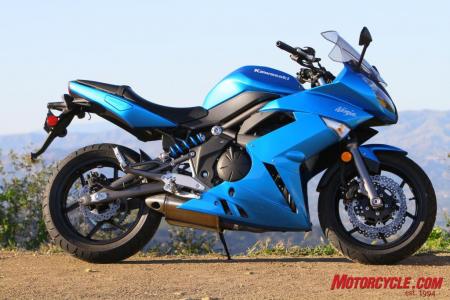 The Ninja The Ninja 650R is as good at a relaxed pace or commuting as it is for more aggressive riding. |
tweaks to the fuel tank shape, steel semi-double cradle trellis frame,
and suspension settings. A D-shaped swingarm was also part of the
engineered changes, as were larger 27mm piston front brakes, redesigned
fairing, cowl and fender, and an all-digital instrument cluster.
The fairly extensive facelift and tummy tuck helps the middleweight
feel even lower and narrower, augments its functionality, and attempts
to make it more stylistically svelte and pretty too.
Kawasaki says its new front cowl and dual headlight design, for
example, are reminiscent of its sportier brothers (or sisters, you
decide), the Ninja ZX-6R and ZX-10R. And the digital instruments,
complete with bar-graph tach, are modeled on none other than the baddest
Ninja of them all, the ZX-RR MotoGP racer.
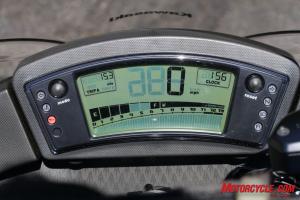 The The digital instrument cluster is inspired by the ZX-RR MotoGP bike but provides data for street riding. |
gets its motivation from a twin-cylinder engine that, while potent,
offers 30 fewer ponies than the ZX-6R while offering a powerband more
suited for daily riding.
Its over-square 83mm bore x 60mm stroke engine employs an 11.3:1
compression ratio, and “chrome composite” plated aluminum cylinders.
Oiling is handled by a semi-dry sump to reduce engine height, and jets
on the connecting rod big ends aim cooling oil to the undersides of the
pistons.
The liquid-cooled, fuel-injected mill also routes coolant through the
engine cases, thus minimizing external hoses and further enabling it to
be narrow and short. Kawasaki says this engine is “the most compact in
its category,” and its dimensions are smaller than the older EX500
engine, and as MO’s writer observed in 2006, this is not a mere
over-bore.
Its 180-degree crankshaft utilizes a counter-balancer to allow for
“extremely smooth operation,” but 2008’s rigid rear engine mounts were
replaced with rubber mounts, so apparently Team Green’s engineers
figured it needed even more smoothness.
Power is channeled through a six-speed transmission, which in
addition to being compact, its cassette-type design could make
maintenance or repairs less involved too, if needed.
Keihin 38mm throttle bodies with sub-throttle valves feed the
air-fuel mix. Kawasaki says it tweaked throttle response to emulate good
old constant-velocity carburetors, while the digitally-controlled
system improves starting, warm-up, drivability, and fuel consumption.
The 300-cell three-way catalytic converter meets demanding Euro-III
emissions regs and is neatly hidden inline with a stylized muffler that
is placed under the engine for optimum mass centralization.
We measured the output of our 2010 Ninja 650 on Hypercycle’s Dynojet
Research dynamometer at 61.8 hp and 41.1 ft-lbs of torque. Power was
down from our 2006 bike’s numbers – also read on a Dynojet Research dyno
– which then told a tale of 65.7 hp and 45.5 ft-lbs of torque. It
should be noted that the Hypercycle dyno has a reputation of being a bit
stingy.
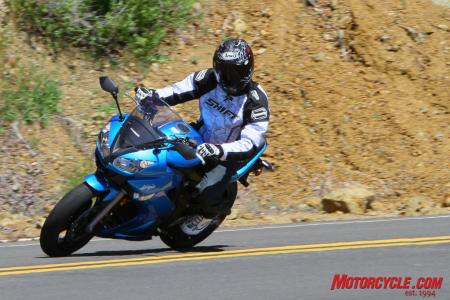 Even Even experienced riders won’t typically scrape down the footpegs with the stock rubber. |
of 48 mpg, and the 650R’s 4.1-gallon fuel tank is large enough so gas
stops don’t have to be too often.
The bike rides on a pretty vanilla but functional 41mm non-adjustable
telescopic fork offering 4.7 inches of travel and an offset laydown
preload-adjustable rear shock with 4.9 inches of travel.
The non-linkage-connected rear shock is easy to adjust with an
included spanner tool, and more importantly, its offset position helps
narrow the bike.
Braking duties are handled by dual front 300mm petal-shaped rotors of
the same design as those on the Ninja ZX-6R. They are pinched by
twin-piston calipers. Rear stopping is handled by a 220mm petal rotor
that’s grabbed by a single-piston caliper.
Our bike came shod with 120/70ZR17 front and 160/60ZR17 rear
Bridgestone Battlax BT021 sport-touring tires.
How it all works
At a couple ounces shy of 450 pounds full of fluids, the Ninja 650R
feels light, narrow and nimble.
Its handlebar is pretty high and swept back so you feel like maybe
you are on your grandad’s old Standard Motorcycle. It helps to get off
every now and again for another look at the swoopy fairing and menacing
twin headlights to remind yourself this is a contemporary bike that’s
actually designed for sex appeal and built for speed. The redesigned
fairing gives the 650R a sharper and sportier appearance that we all
appreciated.
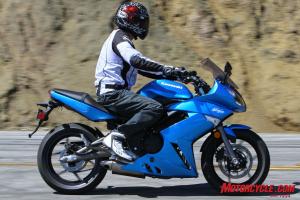 An upright An uprightriding position is part of the Ninja 650R’s broad-based appeal. |
upright riding position are part of the conspiracy to make the bike as
universally appealing as possible. Personally, I’d
swap the bar for one with less rise.
Even with a two-inch lower handlebar, taller riders would find the
riding position to be only mildly forward leaning. At 6’ tall with a 34”
inseam, I find this bike a bit small, but it is not so bad, and I could
contemplate trips of a few hundred miles. The step to the passenger
section does stop me from sliding back as far as I’d sometimes like,
however, and a higher, flatter saddle could make another worthwhile
modification. The Ninja is a better fit for shorter riders.
As for power delivery, its healthy low-end torque was welcome
everywhere we went. On the highway, this bike will do 75-plus-mph all
day long, and roll-on power is good between legal and well-over-legal
speeds (tested under special laboratory conditions, of course!).
Published tests show this bike will sprint to a mid-to-low 12 second
quarter mile, which means beginners will want to give a healthy degree
of respect, if they feel confident enough to start on a bike this fast
at all.
In the canyons, the grunty powerband was felt when sloppy upshifts at
mid to higher rpm would deliver a swift kick in the pants. This served
as etiquette lessons on the topic of good shifting manners, with extra
credit given for a smoother hand when disengaging the clutch.
Romping around curves, the sport-touring tires did not encourage
scraping down of the Ninja’s somewhat high footpegs. Experienced sport
riders might want to opt for premium sticky rubber. The bike does like
to be whipped into any lean angle, however, and holds a line with
minimal effort in part because the wide, tall handlebars give great
leverage.
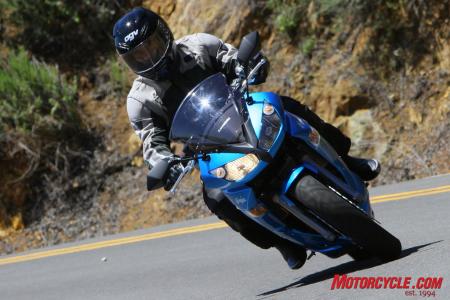 This Ninja This Ninjasteers with low effort and holds a line fairly well. |
suspension can get overwhelmed by a large, fast pilot. Bumping up the
rear spring preload from mid-way to full stiffness enhanced the bike’s
composure under my 185 pounds. Riders weighing significantly more, or
those who regularly ride two-up or want to add luggage, may want to
source stiffer springs.
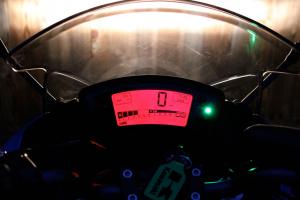 After After dark, illuminated instruments glow dark red. |
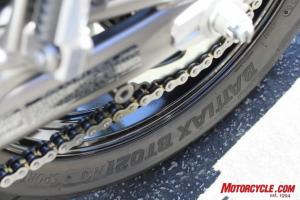 Bridgestone BridgestoneBattlax sport-touring tires get the job done, but we’d fit stickier rubber to exploit the Ninja’s light handling. |
its MotoGP bike, the bar-graph tach is harder to read than a large
analog gauge would be. Otherwise a fuel gauge, two tripmeters and a
clock are useful info to have, and after dark the red-glowing display
looks good. A four-way flasher function for the turn signals is also a
nice touch.
The fairly high and wide windscreen was extensively engineered,
Kawasaki says, and we find it gives no weird buffeting and offers
reasonable protection for cool-weather riding or rain. “The fairing
feels solid and is not buzzy,” noted one of MO’s testers, long-time
roadracer, and all around cool guy, Kaming Ko.
A five-way adjustable clutch lever is another feature useful to adapt
to a wide range of hand sizes.
The larger brakes haul the bike down from any speed as they are
supposed to, but Kevin Duke noted they feel “wooden and numb.” I agree,
but think they are adequate, and if they really became an issue, better
compound aftermarket brake pads and stiffer lines are not-very-expensive
options that should significantly improve these brakes.
Despite the reputation of the Ninja name and the 650R’s sporty
intentions, we believe this bike is really a Standard-style sportbike in
a full-fairing disguise.
While fun to flick around, it offers enough real world power and
comfort for most riders to go anywhere and fulfill a variety of
purposes. It is inviting enough for new riders if they take care to
respect its power, and it will also be reliable for commuters. Further,
it is not too tame for those returning to the sport.
At a reasonable $7,099 MSRP, the Ninja 650R is worth checking out by
anyone looking for a good all-around sporty bike.
Related Reading
2009
Kawasaki ER-6n Review
2009
Naked Middleweight Comparison
2006
Suzuki SV650S v. 2006 Kawasaki Ninja 650R
All Things
Kawasaki on Motorcycle.com
ganahsokmo- Join date : 16/01/2010
Age : 43
 Similar topics
Similar topics» 2008 Kawasaki Ninja 250R Review
» 2010 Kawasaki Ninja 650 vs. 2009 Suzuki GSX650F vs. 2010 Yamaha FZ6R
» 2010 Kawasaki ZX-10R Review
» 2010 Kawasaki Versys Review
» 2010 Kawasaki Z1000 Review
» 2010 Kawasaki Ninja 650 vs. 2009 Suzuki GSX650F vs. 2010 Yamaha FZ6R
» 2010 Kawasaki ZX-10R Review
» 2010 Kawasaki Versys Review
» 2010 Kawasaki Z1000 Review
Page 1 of 1
Permissions in this forum:
You cannot reply to topics in this forum|
|
|



